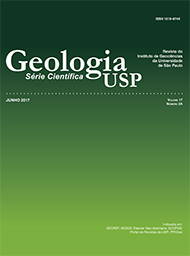Aplicação do laser scanner na análise de estabilidade em escavações subterrâneas: Mina Tabiporã, Campo Largo, PR
DOI:
https://doi.org/10.11606/issn.2316-9095.v17-266Palavras-chave:
Análise Geotécnica, Túnel, Maciços Rochosos, LIDAR.Resumo
Este trabalho demonstra a aplicação do laser scanner (light detection and ranging – LIDAR) na análise geotécnica de queda de blocos em galeria subterrânea. O estudo, realizado em parte da galeria da Mineração Tabiporã, teve como objetivo testar a utilização de dados remotos na determinação da direção de famílias de fraturas e sua comparação com dados diretos, obtidos em campo. A nuvem de pontos georreferenciados, obtida a partir do laser scanner, deu origem ao modelo tridimensional do túnel. A aquisição remota dos dados mostrou-se prática e rápida, fato que favorece a segurança dos trabalhadores e a redução de custos de projetos. No modelo de visualização da nuvem de pontos, foram selecionados conjuntos de pontos que representam planos de descontinuidade na rocha. Esses pontos foram triangulados e resultaram em planos com direção e mergulho, que representam famílias de fraturas. Os dados obtidos indiretamente foram comparados com medidas de planos de fratura adquiridas em campo, na mesma área. A correlação entre os dados, embora parcial, mostrou que a aquisição de dados estruturais pelo método indireto pode ser útil em situações de risco de queda de blocos. O resultado demonstra a utilidade do laser scanner em regiões de difícil acesso, garantindo a segurança das equipes de avaliação; no entanto, ressalta-se que são necessários avanços tecnológicos para tornar o processo de análise indireta mais robusto.
Downloads
Downloads
Publicado
Edição
Seção
Licença
Autores que publicam nesta revista concordam com os seguintes termos:
- Autores mantém os direitos autorais e concedem à revista Geologia USP. Série Científica, o direito de primeira publicação, com o trabalho sob a licença Creative Commons BY-NC-SA (resumo da Licença: https://creativecommons.org/licenses/by-nc-sa/4.0 | texto completo da licença: https://creativecommons.org/licenses/by-nc-sa/4.0/legalcode) que permite o compartilhamento do trabalho de forma não comercial e conferindo os devidos créditos autorais da primeira publicação nesta revista.
- Autores têm autorização para assumir contratos adicionais separadamente, para distribuição não-exclusiva da versão do trabalho publicada nesta revista (publicar em repositório institucional ou como capítulo de livro), conferindo os devidos créditos autorais da primeira publicação nesta revista.
- Autores têm permissão e são estimulados a publicar e distribuir seu trabalho online (em repositórios institucionais ou na sua página pessoal) a qualquer ponto antes ou durante o processo editorial, uma vez que isso pode gerar alterações produtivas, bem como aumentar o impacto e a citação do trabalho publicado (Veja O efeito do Acesso Aberto e downloads no impacto das citações).















